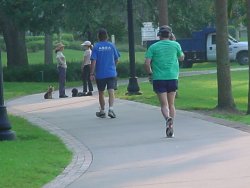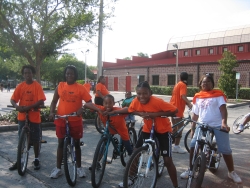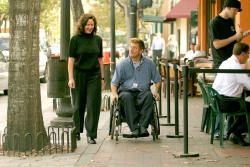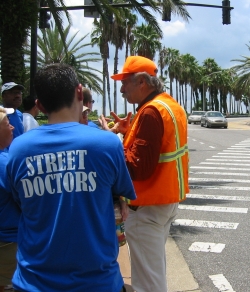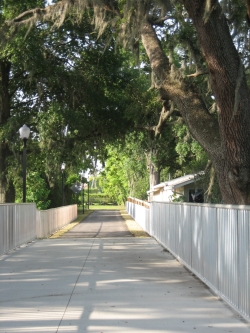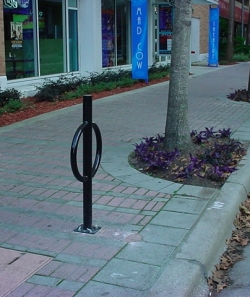Downtown Orlando Transportation Plan
Orlando, Florida
Source: Pedestrian and Bicycle Information Center (PBIC)
Lake Eola Park
photo: Get Active Orlando!
Problem
By 2027 downtown Orlando could add the equivalent of a small city to its population. With the number of residents expected to rise by 157 percent (36,500 people) and employment likely to increase 36 percent (30,000 people), everyday errands — commuting to work, picking up groceries, going to a doctor appointment, a movie, or the coffee shop — could add up to epic congestion. How can the increased trips resulting from growth be transferred from individual cars to other transportation modes (bicycling, walking, transit)?
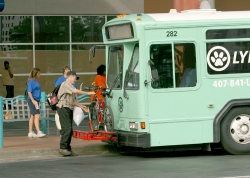
LYNX bus with bike rack
photo: Get Active Orlando!
Background
Orlando is the largest city in Central Florida. Two major highways intersect the downtown; both carry thousands of employees and visitors and are undergoing expansion. Phase I of a planned 62-mile commuter rail system is expected to be running in 2009; the four Orlando stations are located within the study area of the Downtown Transportation Plan.
Parramore Kidz Ride for Pride
photo: City of Orlando
In 2000 the Downtown Outlook Plan articulated the vision of "providing pedestrian and bicycle connections amongst homes, workplaces, cultural events and shopping." Two years later, the Downtown Orlando 20-Point Strategic Plan included several goals that shaped the mission for the Downtown Transportation Plan. The strategic plan emphasized using transportation improvements as a catalyst to create quality "people places" that ensure downtown Orlando is a pedestrian-, bicycle- and transit-friendly environment.
Solution
The Downtown Transportation Plan (DTP; November 2006) built on the research and goals of the two earlier plans to address all transportation modes (transit, bicycle/pedestrian, parking, roadway, and freight). The Bicycle and Pedestrian section's objective is to provide a secure, convenient, efficient, comfortable, and welcoming network for bicyclists and pedestrians. It emphasizes building complete streets that balance safety, convenience, and mobility for all road users.
Central Boulevard at lunch time
photo: Get Active Orlando!
Regardless of individual mode choice, all trips begin and end as a pedestrian trip. Nationally recognized walking authority Dan Burden led walking audits of the study area with the mayor, city commissioners, neighborhood liaisons, and transportation, planning, police, fire, and engineering professionals participating as "Street Doctors". Qualitative assessments of the existing environment evaluated Crime Prevention through Environmental Design (CPTED) and building transparency, streetscape elements, comfort characteristics (shade and width of sidewalks), Americans with Disabilities Act (ADA) compliance, and pedestrian treatments at intersections. The audits built on a previous survey performed as part of the Active Living by Design (ALbD) initiative that measured the bicycle and pedestrian level of service for the study area. General recommendations to improve walkability in the study area include updating the city's land development code, prioritizing sidewalk gaps, designating primary and secondary pedestrian corridors, and specifying streetscape guidelines.
A walking audit with Dan Burden
photo: City of Orlando
To improve the connectivity of the bicycle network, the DTP recommends adding bicycle parking, developing a bike station/bike shop in the downtown core, and completing the Orlando Urban Trail. This trail connects Loch Haven Park, the city's museum and theater campus, to Parramore, an historic African-American neighborhood, along a route that passes several residential neighborhoods, the urban core of downtown, two commuter rail stations, the bus station, a large K-12 school, a hospital campus, and a planned events center.
A new section of the Orlando Urban Trail
photo: Get Active Orlando!
Results
The city council adopted the Downtown Transportation Plan in December 2006. Some of the bicycle and pedestrian recommendations have been implemented, such as adding 70 bike racks throughout downtown, updating streetscape guidelines to include primary and secondary pedestrian corridors, requiring that a bicycle and pedestrian checklist be attached to all plans submitted to the city for review to ensure consistency with land development codes, and updating the bike parking code. A test project for improving street walkability is in progress on a block with small businesses. Pedestrian- and transit-oriented design is part of the planning for commuter rail transit stations.
Although all the recommendations from the Bicycle and Pedestrian section have not yet been funded, most have been added to the city's capital improvement program. Funding comes through a variety of state, regional and municipal agencies, non-profits, and grants. Several projects are already underway:
- $1 million is budgeted for design and construction of the Orlando Urban Trail; most of the trail corridor right of way has been acquired.
- Primary and secondary street enhancements have become standard conditions of approval on plans submitted for development review.
- $17 million has been allocated for the Church Street streetscape and other enhancements to this active downtown corridor.
- $10,000 has been spent to place bike racks around downtown.
One of Orlando’s new bike racks
photo: City of Orlando
Several potential projects identified on the walking audits and listed in the DTP are not yet funded. Sidewalk gaps are addressed by an annual $500,000 appropriation from the general fund and are prioritized by Public Works.
The Downtown Transportation Plan helped Orlando win the "Snowball Effect" award from ALbD. This award recognized the city for building on its bicycle and pedestrian programs step by step in 2004-2006, beginning with walking audits. The audits were used to update existing pedestrian/bicycle codes, guidelines, and levels of service, and to identify needed facility improvements which became part of the transportation plan.
Costs
The Downtown Transportation Plan cost $298,000 and took 18 months to complete. The Community Redevelopment Area (CRA), which encompasses most of downtown Orlando, and the Florida Department of Transportation (FDOT) each contributed $149,000. The CRA is part of the city, but is funded through a special property tax increment.
Web sites
For the Downtown Orlando Transportation Plan:
http://www.cityoforlando.net/transportation/TransportationPlanningDiv/pdf/dtp_docs/DTP1106.pdf
For more on walkability audits, visit: http://www.pedbikeinfo.org/planning/tools_audits.cfm
Contact
Malisa McCreedy, AICP
Transportation Planner
City of Orlando
400 S. Orange Avenue
Orlando, Florida 32801
407.246.3347
malisa.mccreedy@cityoforlando.net
Image sources
Get Active Orlando!, City of Orlando FL
September 2007



